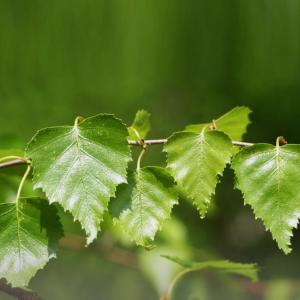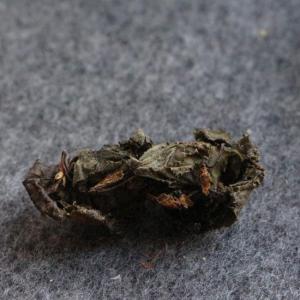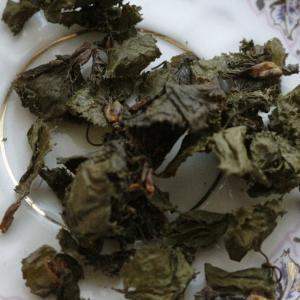
SILVER BIRCH LEAVES (BETULA PENDULA) - PLANTS

BASE / GENERAL DATA
Information submited: May 5, 2016 Modified: May 16, 2018 By: OperaDreamhouse
Betula Pendula, commonly known as Silver Birch or Warty Birch, is a species of tree in the family Betulaceae, native to Europe and parts of Asia, though in southern Europe it is only found at higher altitudes. Its range extends into Siberia, China and southwest Asia in the mountains of northern Turkey, the Caucasus and northern Iran.
Silver Birch is a genuine native, growing here since the end of the Ice Age. The birch is a temperate tree, grown as an ornamental plant, also for its timber. It is used for a range of purposes, from broom-making and steeple-chase fencing to medicines.
The Silver Birch is a medium-sized deciduous tree that owes its common name to the white peeling bark on the trunk. The Silver Birch is a medium-sized deciduous tree, typically reaching 15 to 25 m tall with a slender trunk usually under 40 cm diameter. The twigs are slender and often pendulous and the leaves are roughly triangular with doubly serrate margins and turn yellow in autumn before they fall.
Silver Birch can be used to improve soil quality for other plants to grow. Its deep roots bring otherwise inaccessible nutrients into the tree, which are recycled on to the soil surface when the tree sheds its leaves.
The catkins appear early in spring and release their pollen in clouds during April. The leaves emerge shortly after, a bright emerald green at first, turning golden in autumn.
The leaves have short slender stalks and are 3 to 7 cm long, triangular with broad, untoothed, wedge-shaped bases, slender pointed tips and coarsely double-toothed, serrated margins. They are sticky with resin at first but this dries as they age leaving small white scales. The foliage is a pale to medium green and turns yellow early in the autumn before the leaves fall.
In mid-summer, the female catkins mature and the male catkins expand and release pollen, and wind pollination takes place. The small 1 to 2 mm winged seeds ripen in late summer on pendulous, cylindrical catkins 2 to 4 cm long and 7 mm broad. The seeds are very numerous and are separated by scales, and when ripe, the whole catkin disintegrates and the seeds are spread widely by the wind.
Birches produce an abundance of sap in spring and a cut stump will ‘bleed' for weeks. In North America, a species of woodpecker called the sapsucker taps Birch trees in spring by cutting small wells in the bark and drinking the sap, which oozes out.
In early Celtic mythology, the Birch symbolised renewal and purification. Bundles of Birch twigs were used to drive out the spirits of the old year, and gardeners still use the Birch besom, or broom, to "purify" their gardens. It is also used as a symbol of love and fertility. In Scottish Highland folklore, a barren cow herded with a Birch stick would become fertile, and a pregnant cow would bear a healthy calf.
Pick the leaves in late spring (April) or early summer, while they are still fresh and light green.
Silver Birch is a genuine native, growing here since the end of the Ice Age. The birch is a temperate tree, grown as an ornamental plant, also for its timber. It is used for a range of purposes, from broom-making and steeple-chase fencing to medicines.
The Silver Birch is a medium-sized deciduous tree that owes its common name to the white peeling bark on the trunk. The Silver Birch is a medium-sized deciduous tree, typically reaching 15 to 25 m tall with a slender trunk usually under 40 cm diameter. The twigs are slender and often pendulous and the leaves are roughly triangular with doubly serrate margins and turn yellow in autumn before they fall.
Silver Birch can be used to improve soil quality for other plants to grow. Its deep roots bring otherwise inaccessible nutrients into the tree, which are recycled on to the soil surface when the tree sheds its leaves.
The catkins appear early in spring and release their pollen in clouds during April. The leaves emerge shortly after, a bright emerald green at first, turning golden in autumn.
The leaves have short slender stalks and are 3 to 7 cm long, triangular with broad, untoothed, wedge-shaped bases, slender pointed tips and coarsely double-toothed, serrated margins. They are sticky with resin at first but this dries as they age leaving small white scales. The foliage is a pale to medium green and turns yellow early in the autumn before the leaves fall.
In mid-summer, the female catkins mature and the male catkins expand and release pollen, and wind pollination takes place. The small 1 to 2 mm winged seeds ripen in late summer on pendulous, cylindrical catkins 2 to 4 cm long and 7 mm broad. The seeds are very numerous and are separated by scales, and when ripe, the whole catkin disintegrates and the seeds are spread widely by the wind.
Birches produce an abundance of sap in spring and a cut stump will ‘bleed' for weeks. In North America, a species of woodpecker called the sapsucker taps Birch trees in spring by cutting small wells in the bark and drinking the sap, which oozes out.
In early Celtic mythology, the Birch symbolised renewal and purification. Bundles of Birch twigs were used to drive out the spirits of the old year, and gardeners still use the Birch besom, or broom, to "purify" their gardens. It is also used as a symbol of love and fertility. In Scottish Highland folklore, a barren cow herded with a Birch stick would become fertile, and a pregnant cow would bear a healthy calf.
Pick the leaves in late spring (April) or early summer, while they are still fresh and light green.
Birch tea has a slight taste of Green tea and it is a good tonic for internal organs.
Pick the leaves in spring and early summer while they are still a fresh bright green. They can be used fresh in season or dried for later use. To dry, spread the leaves on a sheet of paper or on a drying screen, which can be made by stretching and stapling a piece of netting to a wooden frame. Dry them in the shade, until crisp when crumbled.
To make the tea, use 4 or 5 leaves per cup or mug of boiling water, and allow to infuse for 5 to 10 minutes. Drink a cupful up to three or four times daily.
Pick the leaves in spring and early summer while they are still a fresh bright green. They can be used fresh in season or dried for later use. To dry, spread the leaves on a sheet of paper or on a drying screen, which can be made by stretching and stapling a piece of netting to a wooden frame. Dry them in the shade, until crisp when crumbled.
To make the tea, use 4 or 5 leaves per cup or mug of boiling water, and allow to infuse for 5 to 10 minutes. Drink a cupful up to three or four times daily.

SPIRITUAL PRACTISES DATA

MEDICINE / HEALTH DATA
Information submited: May 5, 2016 Modified: May 16, 2018 By: OperaDreamhouse
Side effect: Birch is regarded as safe medicinally. Birch bark and leaf in whole herb form have a much lower toxicity. Birch essential oil should be used cautiously and in dilution. Using whole herb applications of Birch leaf and root is preferable. Not to be used for anyone on blood thinning medications, the elderly or fragile.
Birch pollen might cause allergies in people who are sensitive to wild carrot, mugwort, and celery. This has been called the “celery-carrot-mugwort-spice syndrome”. Birch pollen might also cause allergies in people who are sensitive to certain other plants, including apples, soybeans, hazelnuts, and peanuts.
High blood pressure: There is some concern that Birch leaf might increase the amount of salt (sodium) that the body retains, and this can make high blood pressure worse.
Pregnant or nursing: There is not enough reliable information about the safety of taking Birch if you are pregnant or breast-feeding. Ask your herbalist for advice. Use in small quantities.
Use Birch leaf tea for: Spring cleanse, kidney stones, urinary gravel, cystitis, gout, arthritis, rheumatism, psoriasis, eczema, fluid retention, fevers.
Birch pollen might cause allergies in people who are sensitive to wild carrot, mugwort, and celery. This has been called the “celery-carrot-mugwort-spice syndrome”. Birch pollen might also cause allergies in people who are sensitive to certain other plants, including apples, soybeans, hazelnuts, and peanuts.
High blood pressure: There is some concern that Birch leaf might increase the amount of salt (sodium) that the body retains, and this can make high blood pressure worse.
Pregnant or nursing: There is not enough reliable information about the safety of taking Birch if you are pregnant or breast-feeding. Ask your herbalist for advice. Use in small quantities.
Use Birch leaf tea for: Spring cleanse, kidney stones, urinary gravel, cystitis, gout, arthritis, rheumatism, psoriasis, eczema, fluid retention, fevers.
Birch has a multitude of historical uses but is less familiar for its undoubted medicinal properties. The sap
makes a clear and refreshing drink that can be preserved as a wine,
beer, or spirit. The leaves produce a pleasant tea and an infused oil.
In each form, Birch is an excellent tonic anddetoxifier,
mainly working on the urinary system to remove waste products, as in
kidney or bladder stone, gravel, gout, and rheumatism. It reduces fluid
retention and swellings, and clears up many skin problems.
This liquid tree used to grow strong leaves, in medicine young leaves have good qualities as well as in the sap. Birch leaves can be taken in teas, and infused in oil for pain relief.
Birch is a natural pain reliever containing salicylate, the compound found in aspirin. Salicylate relieves the inflammation and pain associated with osteoarthritis, rheumatoid arthritis, gout, and generalized muscle pain.
The fresh leaves or buds of Birch offer a powerful but pleasant tea for general detoxing, urinary complaints, cystitis, rheumatic and arthritic troubles, and gout. Some herbalists add a pinch of sodium bicarbonate to improve the tea's ability to cut high uric acid levels.
Any condition of fluid retention, such as cardiac or renal edema and dropsy, will be helped by the tea. Birch is rich in potassium, so that it does not deplete the body of this mineral in the way that medicaldiuretics do.
The buds of the Birch tree are a rich source of Vitamin C, tannin and flavonoids, which makes them effective in the prevention of viral infections and even the formation of cancer.
This liquid tree used to grow strong leaves, in medicine young leaves have good qualities as well as in the sap. Birch leaves can be taken in teas, and infused in oil for pain relief.
Birch is a natural pain reliever containing salicylate, the compound found in aspirin. Salicylate relieves the inflammation and pain associated with osteoarthritis, rheumatoid arthritis, gout, and generalized muscle pain.
The fresh leaves or buds of Birch offer a powerful but pleasant tea for general detoxing, urinary complaints, cystitis, rheumatic and arthritic troubles, and gout. Some herbalists add a pinch of sodium bicarbonate to improve the tea's ability to cut high uric acid levels.
Any condition of fluid retention, such as cardiac or renal edema and dropsy, will be helped by the tea. Birch is rich in potassium, so that it does not deplete the body of this mineral in the way that medicaldiuretics do.
The buds of the Birch tree are a rich source of Vitamin C, tannin and flavonoids, which makes them effective in the prevention of viral infections and even the formation of cancer.

BEAUTY / COSMETICS DATA
Information submited: May 7, 2016 Modified: May 16, 2018 By: OperaDreamhouse
Silver Birch is good eliminator, Birch tea is also effective as a compress applied directly to the skin for herpes, eczema, and the like.
Traditional healers have long considered the leaves of the White and Silver Birch effective for skin rashes and hair loss. A bath with Birch leaf water is a good way to strengthen the hair roots and prevent problems like dandruff.
Birch can have good results against cellulite. Birch tree contains powerful diuretic properties that help in flushing out harmful toxins, uric acid, and excess water from the body. This in turn helps in eliminating cellulite from the body and treats problems like obesity over time. It helps in maintaining good kidney and liver health.
You can soak birch leaves in water for few hours and then use the strained solution for washing the skin as a treatment for these skin problems. It is also good for healing various other skin irritations.
Traditional healers have long considered the leaves of the White and Silver Birch effective for skin rashes and hair loss. A bath with Birch leaf water is a good way to strengthen the hair roots and prevent problems like dandruff.
Birch can have good results against cellulite. Birch tree contains powerful diuretic properties that help in flushing out harmful toxins, uric acid, and excess water from the body. This in turn helps in eliminating cellulite from the body and treats problems like obesity over time. It helps in maintaining good kidney and liver health.
You can soak birch leaves in water for few hours and then use the strained solution for washing the skin as a treatment for these skin problems. It is also good for healing various other skin irritations.

FOOD / COOKING DATA
COMMENTS
No comments.
Newest mixtures containing Silver Birch Leaves (Betula Pendula):

Natural tonic for acne treatment
May 9, 2016




